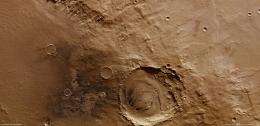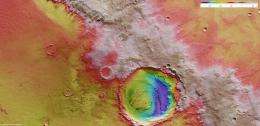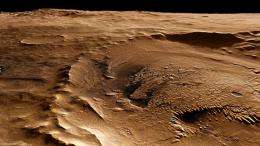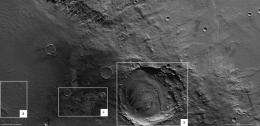Schiaparelli on Mars shaped by wind, water

The small crater embedded in the northwestern rim of the Schiaparelli impact basin features prominently in this new image from ESA’s Mars Express. All around is evidence for past water and the great martian winds that periodically blow.

Schiaparelli is a large impact basin about 460 km in diameter located in the eastern Terra Meridiani region of the equator of Mars. The centre of the basin lies at about 3°S/17°E and is named after the Italian astronomer Giovanni Schiaparelli (1835–1910). Although he also studied Mercury and Venus, he is best known for his observations of the Red Planet.
During the ‘Great Opposition’ of 1877, when Mars passed close to Earth, Schiaparelli mapped the planet, perceiving a number of straight dark lines across the red surface. He assumed that these were natural water-filled channels and used the equivalent Italian word, ‘canali’.
However, other astronomers thought he meant canals, meaning artificial irrigation and transportation routes, which led to a few astronomers, and a large number of the general public, believing that they had been created by intelligent Martians.

Now we know that Schiaparelli’s ‘canali’ were illusions created by the comparatively poor telescopes of the time and there are no water-filled channels on Mars today. Nevertheless, there is evidence in this new picture that water was once present in this region of the planet, perhaps in the form of a lake.
The scene shows a small part of the northwestern area of the Schiaparelli basin with the crater rim, the crater interior and parts of the surrounding highlands. Evidence for water can be seen in the form of dark sediments that appear on the floor of Schiaparelli, resembling those deposited by evaporated lakes on Earth.

The interior of Schiaparelli has been modified by multiple geological processes, including the fall of ejecta blasted upwards by the initial impact, flows of lava to create the smooth plains, and watery sediments. Box 1 shows part of these sedimentary deposits. Also in the crater floor, smaller impact craters have been partially flooded and filled.
The sediments forming the smooth plains in Box 2 have been modified by erosion, either by wind, water or both to form sharp contours such as the skinny plateau at bottom left. In other places, material has been deposited by the wind to form hills and dunes.
The prominent crater in Box 3 is 42 km across and rests on the inner rim of Schiaparelli. The interior of the smaller crater is filled with sediments that appear to form a terrace in the northern part and a delta-like structure near the centre. The latter seems to be partially composed of rounded light-coloured mounds. Dark wind-borne material has accumulated in the southern portion of the crater.
Provided by European Space Agency





















